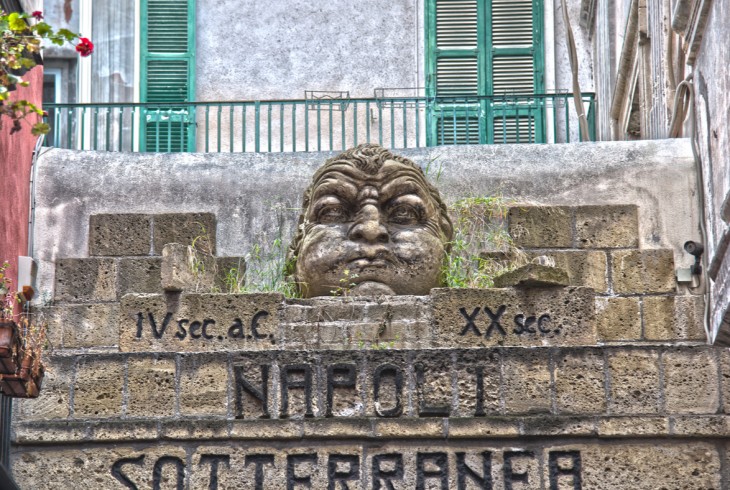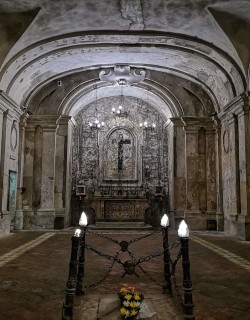To get to the heart of Naples, you have to dig down deep. If you want to understand the city's history, then there's no point measuring it in years, centuries, or even millennia. Measure it instead in meters downwards – in Naples, time is space. This week we went in search of the distant origins of the Parthenopean city in the vibrant historic district of Sanità , for good reason known as Naples' 'Valley of the Dead.' What we found were some of the city's most mysterious subterranean sites concealed far below Sanità's labyrinthine and chaotic scooter-clogged streets.
Disastrously isolated from the surrounding city when the Bourbon kings decided to build a bridge through the area to make reaching their royal palace on the hill of Capodimonte easier in the early 1800s, for much of the 20th century the once well-heeled suburban district had a reputation for poverty and petty crime that meant few visitors ever ventured into this cut-off city-within-a-city. These days though it's in the midst of an urban regeneration that has put the quarter's magnificent churches and sprawling Baroque palaces (not to mention two of Naples' best pizzerie in Pizzeria Concettina a Tre Santi and Pizzeria Starita ) firmly back on the radar.
But there's a lot more to the story of Sanità than the crumbling Baroque monuments that grace its every corner. This was where ancient Neapolitans built their subterranean mausoleums more than a millennium earlier, and as Christianity spread where adherents of the new faith excavated their catacombs. And this history lives on even today: in Naples the dead still plays an active part in people's daily lives, intercessors for their problems and guardians of their hopes and dreams. The point of contact between the living and the dead lies under the ground, in mysterious spaces where souls stalk darkened corridors with one foot in the world and one foot in the afterlife. Read on for our guide to the underground sites you need to see in Sanità !
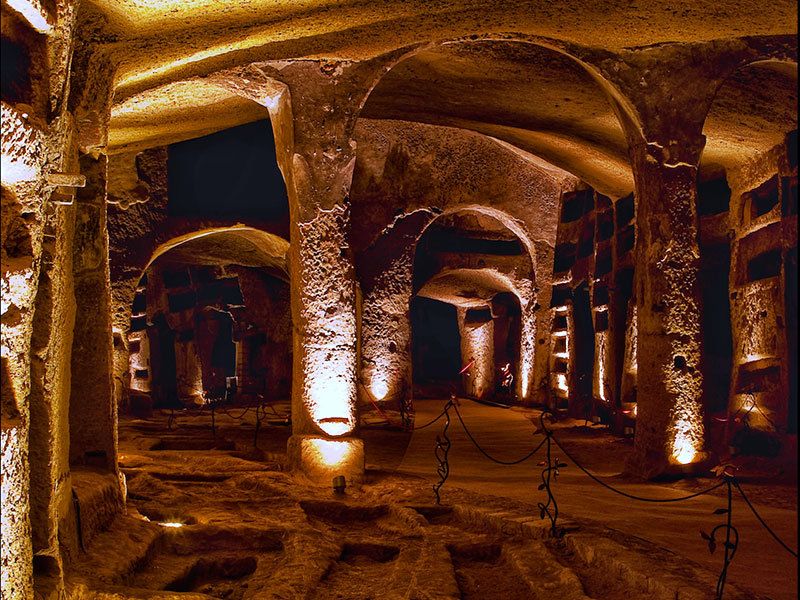
The Catacombs of San Gennaro
The first port of call on our journey to discover Naples' subterranean secrets is the remarkably well-preserved catacomb of San Gennaro . Spreading out over two levels, the history of the catacomb can be traced all the way back to the 2nd century AD , when an aristocratic local family offered their sepulchral holdings to the city's still clandestine Christian community. A remote world of martyrs and miracles seems to live on in these eerie underground passages suffused in an atmospheric half-light, where the tombs of the religion's earliest communities were hewn out of the porous local tuff stone.
Before the Emperor Constantine had his moment of divine revelation on Rome's Milvian bridge and legalized Christianity, the upstart religion was generally considered to be a dangerous and seditious cult in the ancient empire – and so many of those reverentially buried in the Neapolitan catacombs were persecuted for their faith and venerated as martyrs by their peers. The catacomb became an important burial site for Christians when saint Agrippinus , the city's sixth bishop and original patron saint, was interred here. A simple underground church was carved from the bedrock as a space to worship him, and you can still see an altar there today with an opening through which the congregation could see and even touch the saint's precious corpse.
Nearby the city's bishops were later buried in the Crypt of the Bishops , adorned with fabulous mosaics. Naples' most important son was originally interred here - the city's current patron saint Gennaro. The unscrupulous Lombard Prince Sico carried off the precious holy body (except for the head) in an audacious 9th century theft, triumphantly bringing the spoils back to his native Benevento. It would be more than 500 years before head and body were finally reunited again in the cathedral of Naples that bears the saint's name, where the relics occupy pride of place today. The passing of the centuries saw the catacombs looted for their precious contents and even used as a makeshift bomb-shelter for the city's populace during Allied raids in World War II.
Catacombs of San Gennaro , Via Capodimonte, 13. Open Mon-Sat, 10.00-17.00, Sun, 10.00-14.00, €9 (includes entrance to Catacombs of San Gennaro).
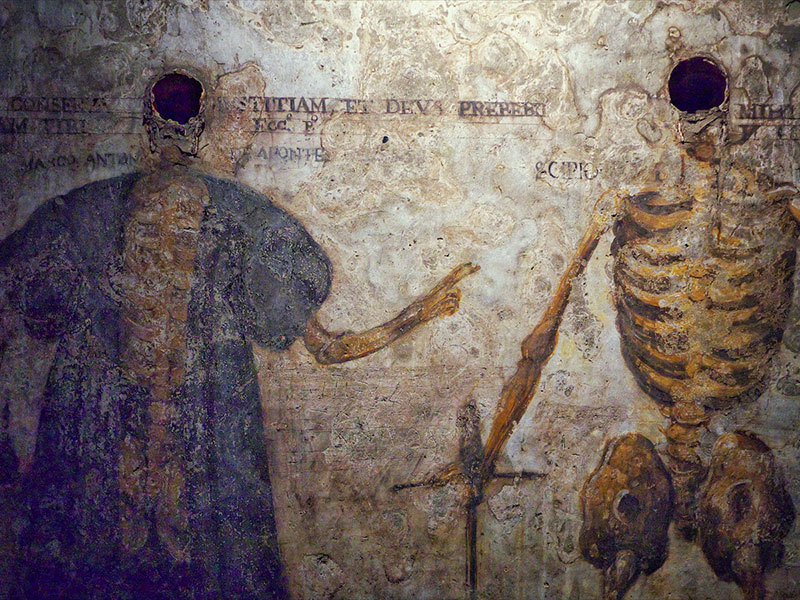
Santa Maria della Sanità and the Catacombs of San Gaudioso
It's just a hop, skip and a jump from the Catacombs of San Gennaro to the next stop on our route, the impressive Baroque church of Santa Maria della Sanità. The basilica's glittering yellow and green majolica dome is spectacular enough, but for our purposes the real treasures to be unearthed here lie deep under the church. Descending beneath the monumental curving polychrome steps leading up to the apse, we find ourselves in the crypt, originally a Paleochristian basilica before the present-day church was built above it in 1602. Descend still further and you'll enter the evocative catacombs of San Joyful .
Gaudioso was a 5th - century African bishop who found his way to Naples after being persecuted in his homeland, and a cult quickly built up around his burial place outside the ancient city walls. If you've walked through the extremely narrow passageways of the Roman Catacombs on our Underground Rome tour, you'll be surprised by how spacious the central passageway is here – over 7 feet wide! Leading off the passageway, the catacomb is divided into small rooms known as cubicoli , richly decorated with beautiful mosaics and frescoes depicting sacred symbols like fish, lamb, grapes and even peacocks (an ancient symbol of immortality widely adopted by the earliest Christians). In one we're transfixed by the 5th- century fresco of Pascentius , where a Romanized Saint Peter dressed in a distinctive toga introduces the deceased Pascentius to Christ. Keep an eye out too for a 5th -century image of the Madonna that's one of the earliest in southern Italy – it's this fresco that gives the church above its name.
During the Middle Ages the catacomb was abandoned as landslides and mudflows inundated the underground passageways. Rediscovered and restored in the 17th century , the Neapolitan elite began to build their tombs here underground once again. Their flamboyantly Baroque sepulchers feature the actual skulls of the deceased set into the wall, with the rest of their bodies frescoed beneath in photo-realistic detail by some of Naples' finest artists.
But the Catacombs of San Gaudioso were also theater to another bizarre custom of veneration. In the almost unbelievably macabre 'draining' death-ritual known as la scolatura , the decaying bodies of aristocrats and clergy were punctured and placed in special niches set into the walls of the catacomb that allowed their putrid bodily fluids to leak out, before finally being ritually cleaned and interred. Pity the poor schiattamuorti tasked with the horrible job of tending to the putrefying corpses, working in almost unimaginably horrible conditions: no light and little air penetrated these subterranean caverns, and the foul space inevitably festered with disease – literally up to their knees in liquefying organs and body parts, the poor schiattamuorti didn't live for long in this land of the dead.
Catacombs of San Gaudioso , Basilica Santa Maria della Sanità, Piazza Sanità 14. Open Mon-Sun, 10.00-13.00, €9 (includes entrance to Catacombs of San Gennaro).
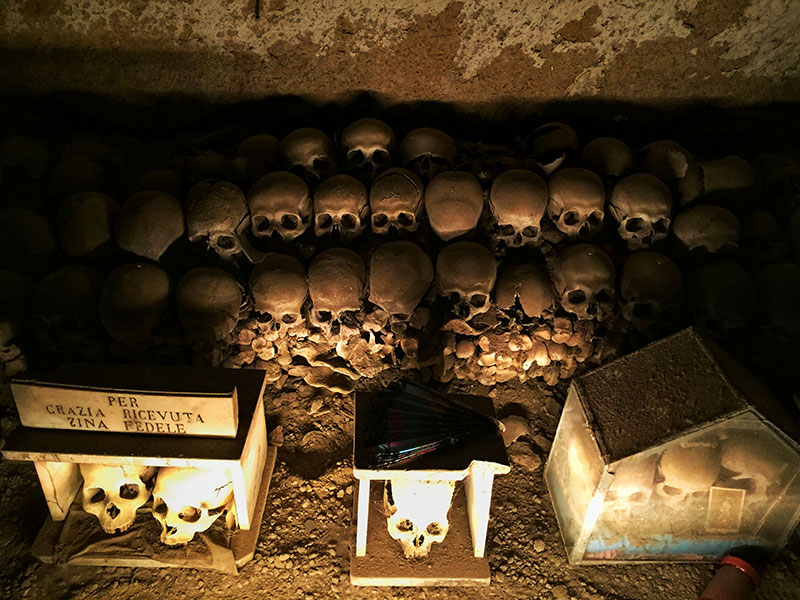
The Fontanelle Cemetery
After a 10 minute walk through the city suburbs to the east of the catacombs we find ourselves in front of the yawning entrance to the cavernous Fontanelle Cemetery, the final stop on our journey through Naples's underground land of the dead. At first glance the Cimiterio delle Fontantelle seems more like a vast quarry than a graveyard, an enormous 3,000 square-metre cavern excavated deep into the tufa bedrock.
For over 400 years this makeshift ossuary has provided sanctuary for the mortal remains of the city's poorest residents, as well as those who perished in the city's recurring plague epidemics. The 17th century was a particularly rough time for the city, as its residents suffered a series of famines, earthquakes, volcanic eruptions and, worst of all, a devastating plague that killed more than half of Naples' population in 1656. The plague unleashed a horrifying spectacle, with the pestilence-ridden corpses of the dead and dying clogging the city streets. With nowhere to inter the remains, locals turned to spaces like this ancient quarry to house the ever-increasing piles of bodies.
In these atmospheric surroundings, surrounded by endless piles of gleaming white bones rising towards the ceiling, we learn about the fascinating cult practice of the anime pezzentelle . Following an ancient tradition equal parts Christian and Pagan, generations of Neapolitans have taken to 'adopting' the cemetery's anonymous unburied skulls, bringing them flowers and candles and offering prayers to rescue their souls from purgatory. In return the adopted spirits look over their earthly benefactors, providing grace or granting petitions for their well-being – sometimes even reporting helping them pick the lottery numbers! Closed for over 40 years by church authorities who considered the custom fetishistic, the cemetery was finally re-opened to visitors in 2010. Today it's one of the city's most fascinating sites, still well off the tourist radar.
Cimitero Delle Fontanelle , Via Fontanelle, 80. Open 7 days, 10.00-17.00, entrance free.
